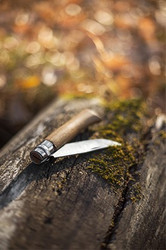9 Things to Know About Folding Knives
15th Jan 2019
Folding knives are found in different shapes and styles. While the ever-growing options are a good thing, they can also be a bit daunting for the first-time buyer. So, if you are planning to purchase a folder and are new to such knives, this post will hopefully guide you to pick the right tool.
Here are some pointers.
1. The feel: The knife should feel like an extension of the hand. If the folder looks perfect and has all the characteristics you want, hold it for some time. If it feels right, buy it.
2. The tip: The most important aspect of any knife is the blade. And in the blade, one of the most significant elements is the tip. Folders come with different tips. For instance, a trailing point bladehas an edge that curves upward and meets the spine (also with a slight upward curve) to form the tip. The big belly surface makes this knife ideal for long slicing cuts. Another is the tanto blade with its chisel-like tip which gives it durability and is good for self-defense. These are just two of the many different styles of blade tips.

3. Serrated and straight-edge blade: Serrated blades are great for cutting through fibrous material. They do not need constant sharpening; however, when they become dull it often takes professional help to get them back to optimum sharpness. Straight-edge blades are the most common in folders. They are easy to sharpen and reprofile and need relatively less maintenance. These knives are good for general cutting tasks.
4. The handle: There is plastic, aluminum, polymer, and titanium, among others. Collectors go for more expensive metal grips but if you are a casual user, it’s about feel and personal preference.

5. Carbon composition: Blade steel is made up of different elements. Of those, carbon content is perhaps the most important. High carbon content helps the blade sustain an edge but renders it vulnerable to corrosion. Blades with low carbon content are good for humid locations or marine tasks.
6. Opening actions: There are essentially three types of opening actions. In a manual folder, you have to physically open the blade using a cut out or thumb stud. In an assisted opening knife, you have to start the action of opening the blade before the mechanism takes over and opens it fully. In automatic folders, you simply have to press a button and the blade will spring out.
7. Sharpening: Keep your tool sharp. There are many ways to go about it – whet stones, honing rods, carbide sharpening devices, pocket sharpeners, etc. If you don’t trust your sharpening skills, take the knife to a professional.
8. Research: It is better to know about what you are buying than go in blind. Also, sometimes you have to spend a little more for that extra quality.
9. Practice: If you plan to get a folder then practice how to use it. They are versatile and useful tools but can also be dangerous if not handled properly.
Don’t forget to check out our amazing range of Folding Knives.
Related blogs- Five EDC Gadgets you must have


 Gift Cards
Gift Cards